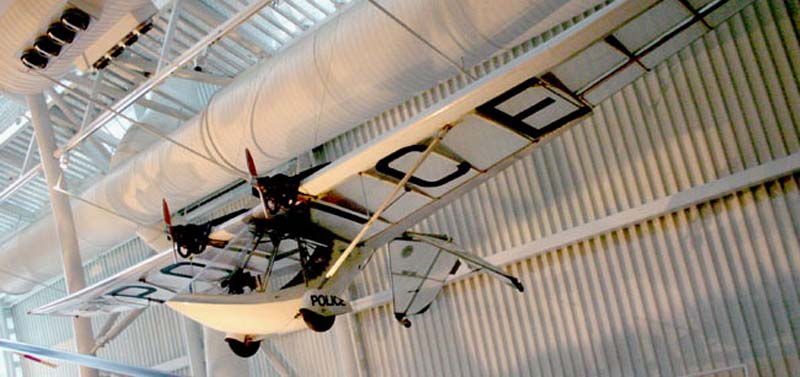|
The
Ultraflight Lazair
is a family of Canadian
designed and built
twin-engine ultralight
aircraft that were sold in
kit form between 1979 and
1984.
The designer of the Lazair,
Dale Kramer, was an
aeronautical engineering
student at the University of
Toronto when he attended the
Oshkosh
EAA convention in 1977. He
was very impressed with the
potential of the ultralight
aircraft designs that he saw
there and returned with a
Superfloater glider kit.
Convinced that improvements
to the design were possible,
Kramer started with a blank
sheet of paper and designed
a completely new aircraft,
even going so far as to
design a custom airfoil for
it.
The design features a
constant taper wing with a
progressive and constant
washout from root to tip.
Combined with an airfoil
that is cambered with
concave portions on both the
top and bottom surfaces,
this produced an aircraft
with optimized low-speed
handling and very gentle
stall characteristics. The
wing is constructed from an
aluminum "D" cell leading
edge, foam ribs and an
aluminum tubular trailing
edge. The aircraft also
featured some of the first
winglets used on light
aircraft.
The very long wing made the
Lazair a good glider, giving
it a 12:1 glide ratio, and
it could be soared in even
light thermal conditions.
Kramer named the aircraft
“Lazair” as a contraction of
“Lazy-Air”, a comment on the
slow cruise speed of the
aircraft, which was about
40 mph (64 km/h).
The Lazair incorporated
standard aircraft materials
but had innovative design
features in every component,
including:
-
winglets
-
full three axis controls
(unusual in ultralights
in 1978)
-
inverted V-tail with
ruddervators
-
transparent PET film
covering for the wings
and tail surfaces
-
twin engines for safety
Initially Mylar was used as
a covering on the wings and
tail, attached to the
airframe with two sided
tape. After the Mylar proved
to have a short service life
due to UV damage, it was
replaced by a more expensive
product, Tedlar.
For control run simplicity
the control stick pivot
point was located above the
pilot with the stick hanging
downwards. The ailerons and
ruddervators on the inverted
V-tail were interconnected
so that turns were made with
connected rudder and aileron
by moving the stick to the
side. Pitch control was via
conventional fore-and-aft
stick movement moving the
ruddervators together as
elevators.
Because Kramer could not
find a suitable engine for
the design that provided the
needed power with
reliability, he opted for
two engines instead, placed
as close together as
possible to reduce yaw when
one failed. The entire
concept was to produce an
aircraft that would fly with
minimum power and so the
prototype had two chainsaw
engines that produced a
total of 11 hp (8.2 kW).
The first Lazair prototype
was constructed by Kramer
and his friend and associate
Peter Corley and first flew
in 1978.
Kramer formed Ultraflight
Aircraft to produce the
design in his home town of
Port Colborne, Ontario.
Sales commenced in 1979
through the subsidiary
"Ultraflight Aircraft
Sales".
Lazair production commenced
in 1979 and was completed in
1984, the company citing
“liability concerns” and the
resulting cost and
availability of insurance as
the reason.
The aircraft were widely
sold in Canada and the
United States and sales
totaled more than 2000,
making the Lazair the most
produced Canadian aircraft
design. The Series II Lazair
was the most produced
individual model.
The Lazair inspired many
other aircraft designers to
use the Lazair wing
construction techniques. The
Blue Yonder Merlin is one
aircraft that uses a wing
based on the Lazair wing.
Source:
Wikipedia
|

